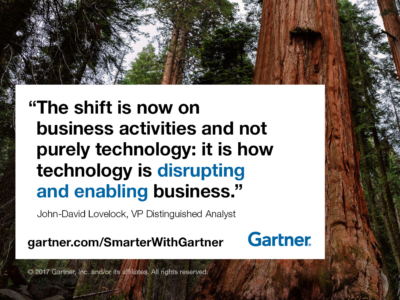Create comfort, confidence and control to successfully navigate changes in the business.
As digital increases the rate of change in the business world, it can create uncertainty in companies and employees. CIOs can use that uncertainty as a leadership tool, but only if they avoid the pitfalls of traditional techniques.
“Some folks feel a little bit uncertain and others are in a near state of panic in many ways because of what they perceive as the rate of change.” said Tina Nunno, VP and Gartner Fellow at Gartner Symposium/ITxpo in Barcelona, Spain. “Right now we’re going through a tremendous amount of technological change and that can create significant uncertainty.”
Traditionally, uncertainty has been used as a catalyst for change in a company with the thinking that people need a reason to change. To get people onboard with change, CIOs might emphasize that the transformation is huge and inevitable, and failure to change will result in catastrophic outcomes.
When employees reach a certain level of stress they don’t innovate, they freeze.
This philosophy might seem rational, but it often has the opposite effect on people. When employees reach a certain level of stress they don’t innovate, they freeze. Not only are they now unable to accept new information, they can’t process data in a rational manner and they can’t change behaviors.
“This is the traditional way in which we’ve all been taught to do change: They won’t move so we light a fire,” said Ms. Nunno. “You create the stress. Instead, I’m going to encourage you to think about yourself as being the one who minimizes stress and maximizes results.”
Create comfort
Forecasting the future is extremely difficult, and generally companies forecast what will change versus what will stay the same. When it comes to change, the first task of a CIO is to gauge how serious the organization is about the transformation. For example, if the CEO is saying she wants a transformation, but the budget is zero and there are no devoted resources, there will be no change. CEOs show priority with money, so if there is no budget, that’s an indication that the CEO doesn’t really care.
Read More: The Art of Saying No
Review the history of transformation at your company and use that as a possible tool for comfort. Emphasize for your team what will stay the same or give them a path to follow, at least for the near term. Provide your team with messages as to what they should continue to do by saying something like “No matter what happens, please continue doing these three things and everything else will be fine for now,” said Ms. Nunno.
Create confidence
Instead of focusing on the challenging road ahead, remember to acknowledge the terrain that’s already been covered. For example, when one company retired any of its IT programs, employees would actually bury a piece of the system and celebrate what they had built. It sent a message that they had built the foundation and everything after that was a continuous line of progress, not something to be viewed as “wrong.” This acknowledgment will allow the team to move confidently forward.
Read More: How IT Leaders Avoid Yes/No Battles
Additionally, stop trying to fix people. Focus on the individual strengths within your team and find a way to compensate for weaknesses. Allowing people to focus on tasks they excel at will allow them to build confidence.
Create control
People like to be in control and are hardwired to need it. But when in a state of uncertainty, employees might not know exactly what the end target looks like, which can cause stress. Employees know that change needs to happen, but not knowing what it’s going to look like can cause tremendous uncertainty. CIOs need to set parameters such as budget, customer involvement or project outline so employees feel like they will eventually end up near where they need to be.
Employees know that change needs to happen, but not knowing what it’s going to look like can cause tremendous uncertainty.
CIOs can also try the “I cut, you choose” method, based on the idea that when children need to split a piece of cake, the best solution is to have one child cut the cake and the other child choose. In the business world, the parallel example is a CIO who needed a group of professors to agree on an IT system. He set up the parameters of budget, risk and general system needs, and asked the professors to present him with three options. The professors were invested in the outcome and had participated in the selection, which offered them some level of control.
A second strategy is the “no-big-deal approach.” When people are told a change will be permanent, they tend to be extremely resistant or argumentative. CIOs should say things like “Let’s try this for a while” and get employees to make a change for a short period of time. The caveat to this is if something isn’t working after the set amount of time, CIOs must be willing to adjust or pull the project to maintain trust.
Get Smarter
Events on Demand
A video replay of this session will be available on Gartner Events on Demand.
Leadership eBook
Lead your team into the digital world. Download the complimentary CIO Leadership eBook.
Facebook Live
Learn how to say no diplomatically. Watch Tina’s Facebook Live Ondemand.
Gartner Symposium/ITxpo 2016
Learn more about driving business performance at Gartner Symposium/ITxpo 2016. Follow news and updates from the events on Twitter using #GartnerSYM.










